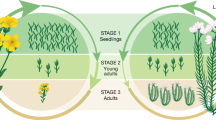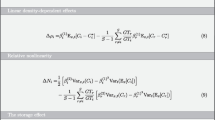Abstract
Explaining coexistence in species-rich communities of primary producers remains a challenge for ecologists because of their likely competition for shared resources. Following Hutchinson’s seminal suggestion, many theoreticians have tried to create diversity through a fluctuating environment, which impairs or slows down competitive exclusion. However, fluctuating environment models often only produce a dozen of coexisting species at best. Here, we investigate how to create richer communities in fluctuating environments, using an empirically parameterized model. Building on the forced Lotka-Volterra model of Scranton and Vasseur (Theor Ecol 9(3):353–363, 2016), inspired by phytoplankton communities, we have investigated the effect of two coexistence mechanisms, namely the storage effect and higher intra- than interspecific competition strengths (i.e., strong self-regulation). We tuned the intra/inter-competition ratio based on empirical analyses, in which self-regulation dominates interspecific interactions. Although a strong self-regulation maintained more species (50%) than the storage effect (25%), we show that none of the two coexistence mechanisms considered could ensure the coexistence of all species alone. Realistic seasonal environments only aggravated that picture, as they decreased persistence relative to a random environment. However, strong self-regulation and the storage effect combined superadditively so that all species could persist with both mechanisms at work. Our results suggest that combining different coexistence mechanisms into community models might be more fruitful than trying to find which mechanism best explains diversity. We additionally highlight that while biomass-trait distributions provide some clues regarding coexistence mechanisms, they cannot indicate unequivocally which mechanisms are at play.




Similar content being viewed by others
References
Abrams PA (1976) Niche overlap and environmental variability. Math Biosci 28(3):357–372. https://doi.org/10.1016/0025-5564(76)90133-4
Adler PB, Ellner SP, Levine JM (2010) Coexistence of perennial plants: an embarrassment of niches. Ecol Lett 13(8):1019–1029. https://doi.org/10.1111/j.1461-0248.2010.01496.x
Adler PB, Smull D, Beard KH, Choi RT, Furniss T, Kulmatiski A, Meiners JM, Tredennick AT, Veblen KE (2018) Competition and coexistence in plant communities: intraspecific competition is stronger than interspecific competition. Ecol Lett 21(9):1319–1329. https://doi.org/10.1111/ele.13098
Armstrong R, McGehee R (1980) Competitive exclusion. Am Nat 115 (2):151–170. https://doi.org/10.1086/283553
Ashby B, Watkins E, Lourenço J, Gupta S, Foster KR (2017) Competing species leave many potential niches unfilled. Nat Ecol Evol 1(10):1495–1501. https://doi.org/10.1038/s41559-017-0295-3
Bagchi R, Gallery RE, Gripenberg S, Gurr SJ, Narayan L, Addis CE, Freckleton RP, Lewis OT (2014) Pathogens and insect herbivores drive rainforest plant diversity and composition. Nature 506 (7486):85–88. https://doi.org/10.1038/nature12911
Barabás G, Meszéna G, Ostling A (2012) Community robustness and limiting similarity in periodic environments. Theor Ecol 5(2):265–282. https://doi.org/10.1007/s12080-011-0127-z
Barabás G, D’Andrea R, Rael R, Meszéna G, Ostling A (2013) Emergent neutrality or hidden niches? Oikos 122(11):1565–1572. https://doi.org/10.1111/j.1600-0706.2013.00298.x
Barabás G, Michalska-Smith MJ, Allesina S (2017) Self-regulation and the stability of large ecological networks. Nat Ecol Evol 1(12):1870–1875. https://doi.org/10.1038/s41559-017-0357-6
Barraquand F, Picoche C, Maurer D, Carassou L, Auby I (2018) Coastal phytoplankton community dynamics and coexistence driven by intragroup density-dependence, light and hydrodynamics. Oikos 127 (12):1834–1852. https://doi.org/10.1111/oik.05361
Bolker B, Pacala S (1999) Spatial moment equations for plant competition: understanding spatial strategies and the advantages of short dispersal. Am Nat 153(6):575–602. https://doi.org/10.1086/303199
Bolker BM (2003) Combining endogenous and exogenous spatial variability in analytical population models. Theor Popul Biol 64(3):255–270. https://doi.org/10.1016/S0040-5809(03)00090-X
Boyce DG, Petrie B, Frank KT, Worm B, Leggett WC (2017) Environmental structuring of marine plankton phenology. Nat Ecol Evol 1:1484–1494. https://doi.org/10.1038/s41559-017-0287-3
Carmel Y, Suprunenko YF, Kunin WE, Kent R, Belmaker J, Bar-Massada A, Cornell SJ (2017) Using exclusion rate to unify niche and neutral perspectives on coexistence. Oikos 126(10):1451–1458. https://doi.org/10.1111/oik.04380
Chesson P (1994) Multispecies competition in variable environments. Theor Popul Biol 45:227–276. https://doi.org/10.1006/tpbi.1994.1013
Chesson P, Huntly N (1997) The roles of harsh and fluctuating conditions in the dynamics of ecological communities. Am Nat 150(5):519–553. https://doi.org/10.1086/286080
Chesson P (2000) Mechanisms of maintenance of species diversity. Ann Rev Ecol Syst 31:343–366. https://doi.org/10.1146/annurev.ecolsys.31.1.343
Chesson P (2018) Updates on mechanisms of maintenance of species diversity. J Ecol 106(5):1773–1794. https://doi.org/10.1111/1365-2745.13035
Comita LS, Queenborough SA, Murphy SJ, Eck JL, Xu K, Krishnadas M, Beckman N, Zhu Y (2014) Testing predictions of the Janzen-Connell hypothesis: a meta-analysis of experimental evidence for distance- and density-dependent seed and seedling survival. J Ecol 102(4):845–856. https://doi.org/10.1111/1365-2745.12232
Dakos V, Benincà E, van Nes EH, Philippart CJM, Scheffer M, Huisman J (2009) Interannual variability in species composition explained as seasonally entrained chaos. Proc R Soc B Biol Sci 276(1669):2871–2880. https://doi.org/10.1098/rspb.2009.0584
D’Andrea R, Ostling A (2016) Challenges in linking trait patterns to niche differentiation. Oikos 125 (10):1369–1385. https://doi.org/10.1111/oik.02979
D’Andrea R, Ostling A, O’Dwyer J (2018) Translucent windows: how uncertainty in competitive interactions impacts detection of community pattern. Ecol Lett 21(6):826–835. https://doi.org/10.1111/ele.12946
D’Andrea R, Riolo M, Ostling A (2019) Generalizing clusters of similar species as a signature of coexistence under competition. PLOS Comput Biol 15(1):e1006688. https://doi.org/10.1371/journal.pcbi.1006688
Descamps-Julien B, Gonzalez A (2005) Stable coexistence in a fluctuating environment: an experimental demonstration. Ecol 86(10):2815–2824. https://doi.org/10.1890/04-1700
Ellner SP, Snyder RE, Adler PB (2016) How to quantify the temporal storage effect using simulations instead of math. Ecol Lett 19(11):1333–1342. https://doi.org/10.1111/ele.12672
Ellner SP, Snyder RE, Adler PB, Hooker G (2019) An expanded modern coexistence theory for empirical applications. Ecol Lett 22(1):3–18. https://doi.org/10.1111/ele.13159
Fox JW (2013) The intermediate disturbance hypothesis should be abandoned. Trends Ecol Evol 28(2):86–92. https://doi.org/10.1016/j.tree.2012.08.014
Gravel D, Canham CD, Beaudet M, Messier C (2006) Reconciling niche and neutrality: the continuum hypothesis. Ecol Lett 9(4):399–409. https://doi.org/10.1111/j.1461-0248.2006.00884.x
Hastings A, Abbott KC, Cuddington K, Francis T, Gellner G, Lai YC, Morozov A, Petrovskii S, Scranton K, Zeeman ML (2018) Transient phenomena in ecology. Science 361(6406):eaat6412. https://doi.org/10.1126/science.aat6412
Haydon D (1994) Pivotal assumptions determining the relationship between stability and complexity: an analytical synthesis of the stability-complexity debate. Am Nat 144(1):14–29. https://doi.org/10.1086/285658
Holt R (2006) Emergent neutrality. Trends Ecol Evol 21(10):531–533. https://doi.org/10.1016/j.tree.2006.08.003
Hubbell SP (2001) The unified neutral theory of biodiversity and biogeography (MPB-32). Princeton University Press, Princeton
Huisman J, Johansson AM, Folmer EO, Weissing FJ (2001) Towards a solution of the plankton paradox: the importance of physiology and life history. Ecol Lett 4(5):408–411. https://doi.org/10.1046/j.1461-0248.2001.00256.x
Hutchinson GE (1961) The paradox of the plankton. Am Nat 95(882):137–145. https://doi.org/10.1086/282171
Jabot F, Lohier T (2016) Non-random correlation of species dynamics in tropical tree communities. Oikos 125(12):1733–1742. https://doi.org/10.1111/oik.03103
Jiang L, Morin PJ (2007) Temperature fluctuation facilitates coexistence of competing species in experimental microbial communities. J Anim Ecol 76(4):660–668. https://doi.org/10.1111/j.1365-2656.2007.01252.x
Kawatsu K, Kondoh M (2018) Density-dependent interspecific interactions and the complexity–stability relationship. Proc R Soc B 285(1879):20180698. https://doi.org/10.1098/rspb.2018.0698
Kokkoris GD, Jansen VAA, Loreau M, Troumbis AY (2002) Variability in interaction strength and implications for biodiversity. J Anim Ecol 71(2):362–371. https://doi.org/10.1046/j.1365-2656.2002.00604.x
Kuang JJ, Chesson P (2009) Coexistence of annual plants: generalist seed predation weakens the storage effect. Ecol 90(1):170–182. https://doi.org/10.1890/08-0207.1
Kuang JJ, Chesson P (2010) Interacting coexistence mechanisms in annual plant communities: frequency-dependent predation and the storage effect. Theor Popul Biol 77(1):56–70. https://doi.org/10.1016/j.tpb.2009.11.002
Li L, Chesson P (2016) The effects of dynamical rates on species coexistence in a variable environment: the paradox of the plankton revisited. Am Nat 188(2):E46–E58. https://doi.org/10.1086/687111
Litchman E, Klausmeier CA (2001) Competition of phytoplankton under fluctuating light. Am Nat 157 (2):170–187. https://doi.org/10.1086/318628
Loranger J, Munoz F, Shipley B, Violle C (2018) What makes trait-abundance relationships when both environmental filtering and stochastic neutral dynamics are at play? Oikos 127:1735–1745. https://doi.org/10.1111/oik.05398
Miller ET, Klausmeier CA (2017) Evolutionary stability of coexistence due to the storage effect in a two-season model. Theor Ecol 10(1):91–103. https://doi.org/10.1007/s12080-016-0314-z
Moisan JR, Moisan TA, Abbott MR (2002) Modelling the effect of temperature on the maximum growth rates of phytoplankton populations. Ecol Model 153(3):197–215. https://doi.org/10.1016/S0304-3800(02)00008-X
Mordecai EA (2015) Pathogen impacts on plant diversity in variable environments. Oikos 124(4):414–420. https://doi.org/10.1111/oik.01328
Murrell DJ, Law R (2002) Heteromyopia and the spatial coexistence of similar competitors. Ecol Lett 6 (1):48–59. https://doi.org/10.1046/j.1461-0248.2003.00397.x
Mutshinda CM, O’Hara RB, Woiwod IP (2009) What drives community dynamics? Proc R Soc B Biol Sci 276(1669):2923–2929. https://doi.org/10.1098/rspb.2009.0523
Pigolotti S, López C, Hernández-García E, Andersen K (2010) How Gaussian competition leads to lumpy or uniform species distributions. Theor Ecol 3(2):89–96. https://doi.org/10.1007/s12080-009-0056-2
Reynolds CS (2006) The ecology of phytoplankton. Cambridge University Press, Cambridge
Rinaldi S, Murator S, Kuznetsov Y (1993) Multiple attractors, catastrophes and chaos in seasonally perturbed predator-prey communities. Bull Math Biol 55(1):15–35. https://doi.org/10.1007/BF02460293
Ruokolainen L, Lindén A, Kaitala V, Fowler M (2009) Ecological and evolutionary dynamics under coloured environmental variation. Trends Ecol Evol 24(10):555–563. https://doi.org/10.1016/j.tree.2009.04.009
Sakavara A, Tsirtsis G, Roelke DL, Mancy R, Spatharis S (2018) Lumpy species coexistence arises robustly in fluctuating resource environments. Proc Natl Acad Sci 115(4):738–743. https://doi.org/10.1073/pnas.1705944115
Scheffer M, Rinaldi S, Kuznetsov Y, van Nes E (1997) Seasonal dynamics of Daphnia and algae explained as a periodically forced predator-prey system. Oikos 80(3):519. https://doi.org/10.2307/3546625
Scheffer M, van Nes EH (2006) Self-organized similarity, the evolutionary emergence of groups of similar species. Proc Natl Acad Sci 103(16):6230–6235. https://doi.org/10.1073/pnas.0508024103
Scranton K, Vasseur DA (2016) Coexistence and emergent neutrality generate synchrony among competitors in fluctuating environments. Theor Ecol 9(3):353–363. https://doi.org/10.1007/s12080-016-0294-z
Segura AM, Calliari D, Kruk C, Conde D, Bonilla S, Fort H (2011) Emergent neutrality drives phytoplankton species coexistence. Proc R Soc B Biol Sci 278 (1716):2355–2361. https://doi.org/10.1098/rspb.2010.2464
Segura AM, Kruk C, Calliari D, Garcìa-Rodriguez F, Conde D, Widdicombe CE, Fort H (2013) Competition drives clumpy species coexistence in estuarine phytoplankton. Sci Rep 3:1037. https://doi.org/10.1038/srep01037
Snyder RE (2008) When does environmental variation most influence species coexistence? Theor Ecol 1 (3):129–139. https://doi.org/10.1007/s12080-008-0015-3
Sommer U (1984) The paradox of the plankton: Fluctuations of phosphorus availability maintain diversity of phytoplankton in flow-through cultures. Limnol Oceanogr 29(3):633–636. https://doi.org/10.4319/lo.1984.29.3.0633
Stump SM (2017) Multispecies coexistence without diffuse competition; or, why phylogenetic signal and trait clustering weaken coexistence. Am Nat 190(2):213–228. https://doi.org/10.1086/692470
Taylor RA, White A, Sherratt JA (2013) How do variations in seasonality affect population cycles?. Proc R Soc B Biol Sci 280(20122714). https://doi.org/10.1098/rspb.2012.2714
Tyson R, Lutscher F (2016) Seasonally varying predation behavior and climate shifts are predicted to affect predator-prey cycles. Am Nat 188(5):539–553. https://doi.org/10.1086/688665
Vasseur DA, Yodzis P (2004) The color of environmental noise. Ecology 85 (4):1146–1152. https://doi.org/10.1890/02-3122
Vesipa R, Ridolfi L (2017) Impact of seasonal forcing on reactive ecological systems. J Theor Biol 419:23–35. https://doi.org/10.1016/j.jtbi.2017.01.036
Winder M, Cloern JE (2010) The annual cycles of phytoplankton biomass. Philosop Trans Royal Soc B: Biol Sci 365(1555):3215–3226. https://doi.org/10.1098/rstb.2010.0125
Wootton JT, Emmerson M (2005) Measurement of interaction strength in nature. Ann Rev Ecol Evol Syst 36(1):419–444. https://doi.org/10.1146/annurev.ecolsys.36.091704.175535
Zhao XQ (1991) The qualitative analysis of n-species Lotka-Volterra periodic competition systems. Math Comput Model 15(11):3–8. https://doi.org/10.1016/0895-7177(91)90100-L
Acknowledgments
We thank Alix Sauve for thoughtful comments and some bibliographic references. We are very grateful to György Barabás and an anonymous referee for their constructive feedback.
Funding
This study was supported by the French ANR through LabEx COTE (ANR-10-LABX-45).
Author information
Authors and Affiliations
Corresponding author
Electronic supplementary material
Below is the link to the electronic supplementary material.
Rights and permissions
About this article
Cite this article
Picoche, C., Barraquand, F. How self-regulation, the storage effect, and their interaction contribute to coexistence in stochastic and seasonal environments. Theor Ecol 12, 489–500 (2019). https://doi.org/10.1007/s12080-019-0420-9
Received:
Accepted:
Published:
Issue Date:
DOI: https://doi.org/10.1007/s12080-019-0420-9




